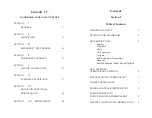
AND SYMBOLS
CAS
Calibrated Airspeed is the indicated speed of an
airplane, corrected for “position error” and instrument
error. Calibrated airspeed is equal to true airspeed in
standard atmosphere at sea level.
GS
Ground Speed is the speed of an airplane rela
-
tive to the ground.
IAS
Indicated Air Speed is the speed of an airplane
as shown on the airspeed indicator when corrected
for instrument error. IAS values published in this hand
-
book assumes zero instrument error.
KCAS
Calibrated Airspeed expressed in “knots”.
KIAS
Indicated Airspeed expressed in “knots”.
TAS
True Airspeed is the airspeed of an airplane rel
-
ative to undisturbed air which is the CAS corrected for
altitude, temperature and compressibility.
V
A
Maneuvering Speed is the maximum speed at
which application of full available
aerodynamic control will not overstress the air
-
plane.
V
FE
Maximum Flap Extend Speed is the highest
speed permissible with wing flaps in a prescribed ex-
tended position.
V
LE
Maximum Landing Gear Extended Speed is
the maximum speed at which an airplane can be safely
flown with the landing gear extended.
V
LO
Maximum Landing Gear Operating Speed is the
maximum speed at which the landing gear can be safely
extended or retracted.
V
NE
Never Exceed Speed is the speed limit that may
not be exceeded at any time.
V
NO
/V
C
Maximum Structural Cruising Speed is
the speed that should not be exceeded except in smooth
air and then only with caution.
V
S
Stalling Speed or the minimum steady flight
speed at which the airplane is controllable.
V
SO
Stalling Speed or the minimum steady flight
speed at which the airplane is controllable in the land
-
ing configuration.
V
X
Best Angle-of-Climb Speed is the airspeed
which delivers the greatest gain of altitude in the short
-
est possible horizontal distance.
V
Y
Best Rate-of-Climb Speed is the airspeed which
delivers the greatest gain in altitude in the shortest pos
-
sible time.
METEOROLOGICAL TERMINOLOGY







































